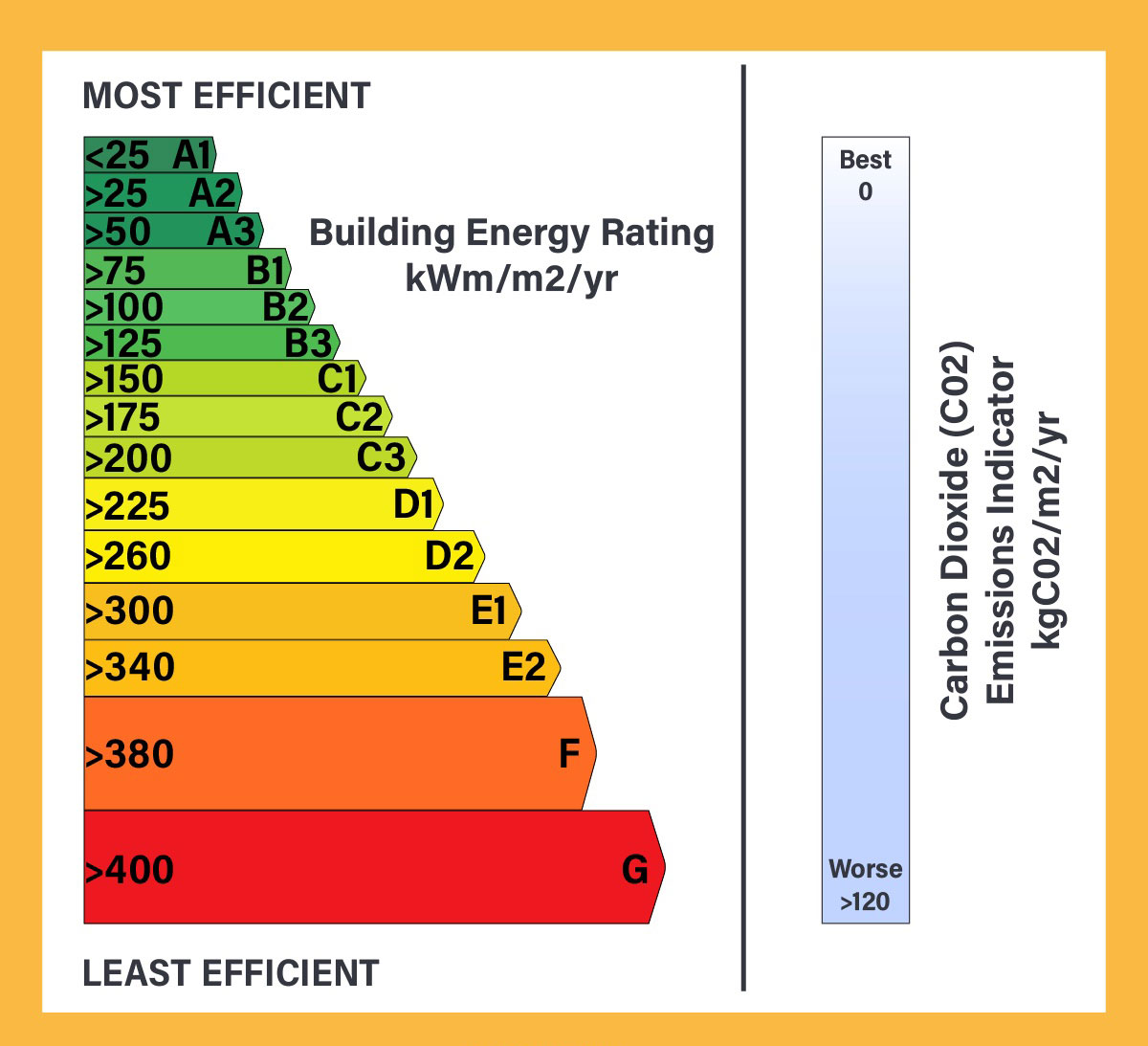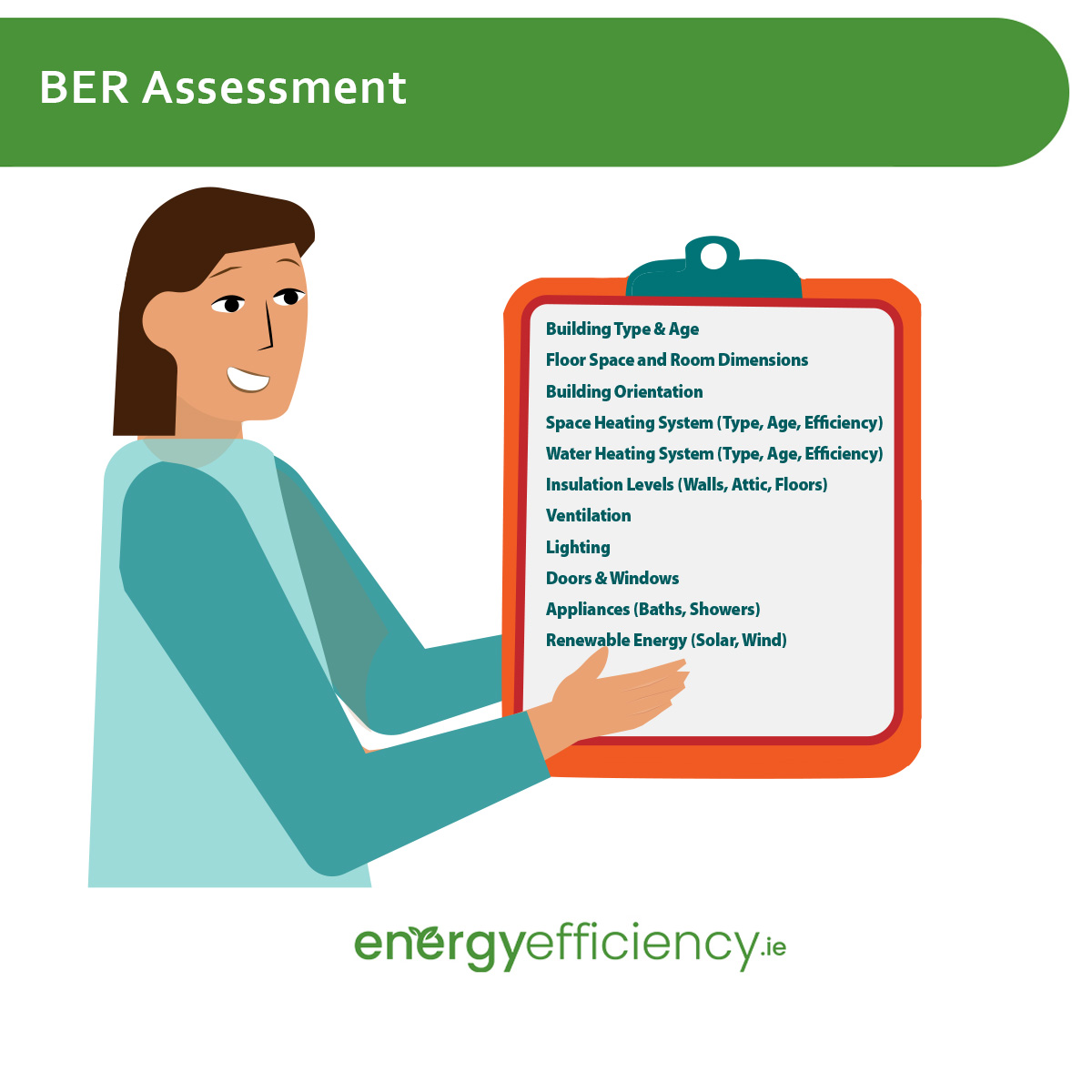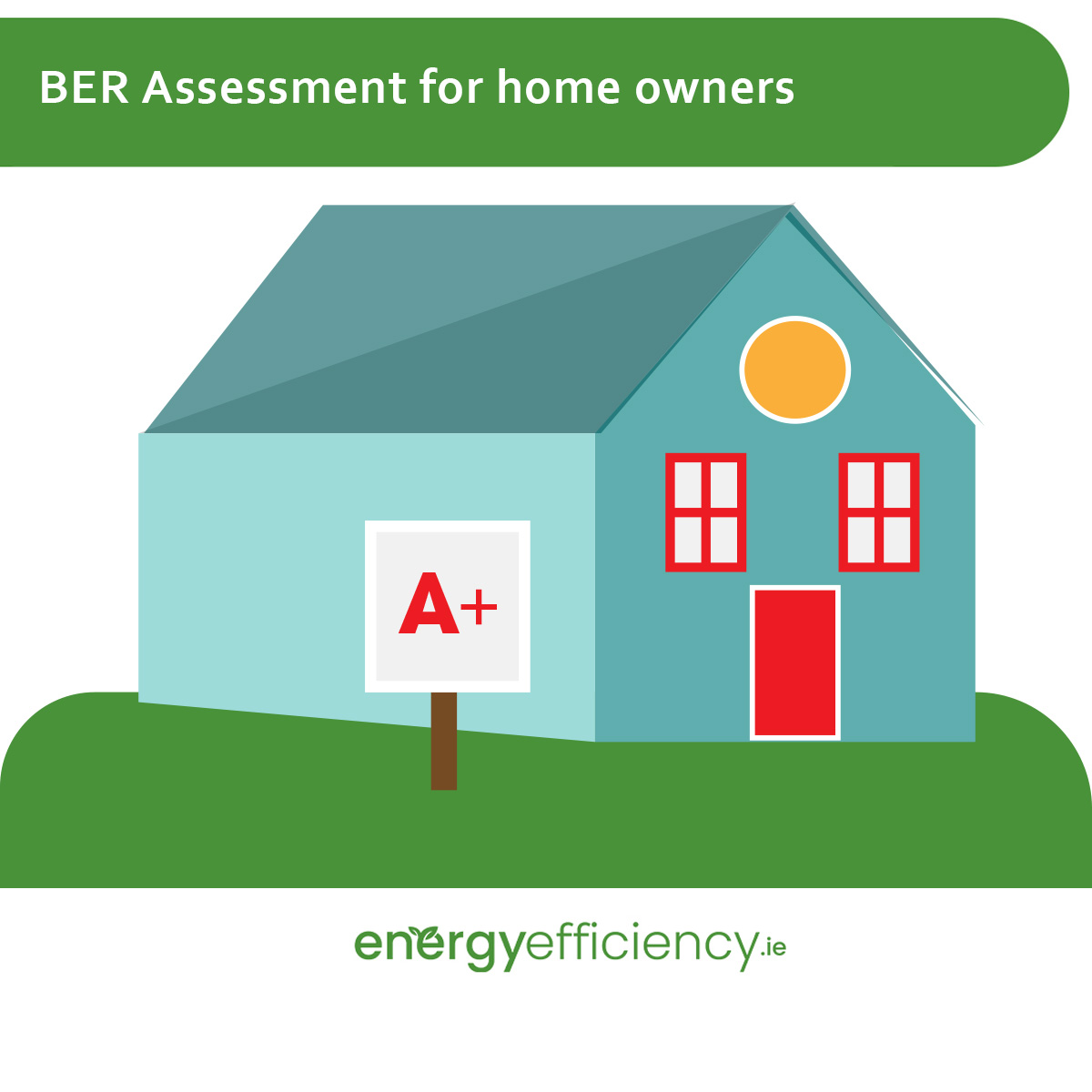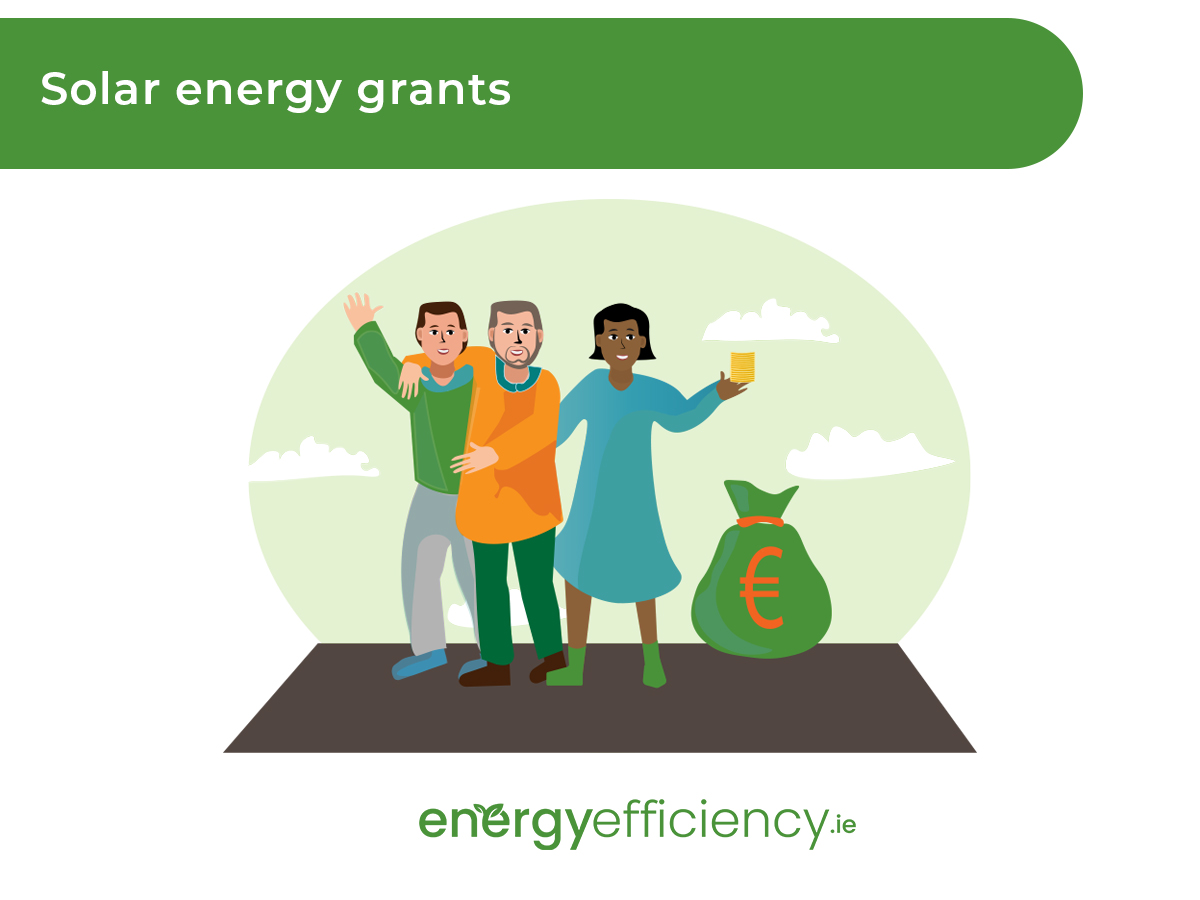What is a BER Cert – Understanding the Building Energy Rating

Written by: Briain Kelly
Published: August 16, 2024
Last updated: October 19, 2025
Reading time: 4 mins
A Building Energy Rating (BER) Certificate is a measure of a property’s energy efficiency graded on a scale. It is meant to allow homeowners and prospective buyers to compare the energy performance of similar buildings.
The better the BER, which comes on a scale of A – G, the less energy it takes to heat, and the less carbon dioxide (CO2) emissions are produced by heating it.
A better BER will mean less expensive heating bills and a more comfortable, environmentally friendly home.
Getting a BER is required in many instances now, and even if not required it can still be an extremely helpful tool to allow homeowners to understand the energy efficiency of their property, and how they can improve on it.
How is the BER Calculated
The BER certification is assessed via the Domestic Energy Assessment Procedure (DEAP) methodology for assessing a home’s energy performance and carbon emissions from space heating, water heating, ventilation, and lighting.
The DEAP methodology expresses the energy performance of a home through its primary energy consumption in kilowatt hours per metre squared of the property per year (kWh/m²/year). The carbon emissions from the property are expressed as kilograms of CO2 emitted per metre squared of the property per year.
This will be shown on the BER Cert with a specific calculation of each for your home, and where that falls in the A – G range.
A1 BER Certificate: Primary Energy Consumption – ≤25 kWh/m²/year & Carbon Dioxide (CO2) Emissions – 0 kgCO2/m²/yr
G BER Certificate: Primary Energy Consumption – >450 kWh/m²/year & Carbon Dioxide (CO2) Emissions – >120 kgCO2/m²/yr
The DEAP Assessment uses a Calculated Energy Consumption which is independent of the number of people living in the property, and the level of heating they use.
- Occupancy and hot water requirements are based on floor area.
- Assumes a standard heating temperature and seasonal usage.
- The same level of lighting in all dwellings.

Getting a BER Assessment
Getting a BER Cert must be done by an SEAI registered Assessor who will inspect your home and each room. The assessor will look at individual elements such as the heating systems, ventilation, and elements of the building fabric.
Elements of the survey will include:
- Building Type & Age
- Floor Space and Room Dimensions
- Building Orientation
- Space Heating System (Type, Age, Efficiency)
- Water Heating System (Type, Age, Efficiency)
- Insulation Levels (Walls, Attic, Floors)
- Ventilation
- Lighting
- Doors & Windows
- Appliances (Baths, Showers)
- Renewable Energy (Solar, Wind)

During the survey, the assessor will also ask if any retrofit of home improvements have been carried out. If they have the homeowner will be expected to provide documentation backing this up.
Why Do I Need a BER
It is now a legal requirement for any home being sold or rented in Ireland to have a BER. This will allow the prospective buyers or tenants to compare with similar properties and estimate what their energy bills are likely to be.
It is also typically required for all newly built homes to have a BER of A2 or greater in Ireland now to meet energy efficiency standards.
Getting a BER Assessment done can also be extremely useful for homeowners who are not planning on selling or renting, but want to improve their property. Having the assessment carried out can point out the best ways in which the energy efficiency of the property.
Lastly, a BER Assessment is typically required as part of the SEAI’s grant process for home improvement grants.

BER Assessment and SEAI Grants
The SEAI offers several grants for energy efficiency upgrades to homes which can help with the cost of Insulation, Solar PV, or Heat Pumps.
Depending on which part of the grant scheme a person is applying for a BER Certificate may be required before or after the works are carried out before receiving a grant, or both.

Better Energy Homes
Individual grants offered under the Better Energy Homes Scheme require a BER Assessment to be carried out after the upgrade works have been completed to receive the grant payment.
Warmer Energy Homes Scheme
These fully funded home improvements are aimed at providing a range of energy efficiency upgrades to the least efficient homes in Ireland and for people on lower incomes.
One of the requirements for this scheme is that for a property to qualify it must have a preexisting BER of C, D, E, F or G. After the home upgrades are completed, a fresh assessment will be carried out.
One Stop Shop
The National Home Energy Upgrade Scheme, also called the One Stop Shop scheme, aims to carry out all-in-one home upgrades which must be able to bring a property up to a BER of B2 or better once they have been completed.
How Much Does it Cost to Get a BER
The cost of getting a BER Cert for a property will vary based on the assessor and the type and size of the home in question.
Typically an apartment will cost in the region of €150 for a BER Assessment. Other properties such as a house, duplex, or penthouse will cost approximately €200 – €300 to get a BER.
What If a Property Already Has a BER
Before getting an assessor in, it’s probably worthwhile to check if a property already has a BER Certificate. The SEAI operates a National BER Register which can be easily searched online.
To look up a BER Certificate and the Advisory Report accompanying it one of two things will be required.
- The Meter Point Reference Number (MPRN) of the property. This can be found on the top of any electricity bill.
- The BER/DEC number of the certificate, which is assigned to the building when it is first assessed.
If the BER was published before July 6, 2021, then the MPRN will be required to access the Advisory Report.
How to Improve a BER
There are multiple ways to improve the fabric of a building which can significantly improve its BER.
Adding insulation to the attic, walls and floors of a home are the best ways to massively improve its energy efficiency. Insulation for piping and the hot water cylinder can also help to reduce heat loss and improve the efficiency of the heating system.
Repairing and upgrading the doors and windows in your home can reduce heat loss by as much as 10% through measures such as draught-proofing and double or triple glazing.
Having renewable energy sources such as solar panels installed on a home can drastically cut down its energy requirements and make it far more environmentally friendly and energy efficient.
Installing a new heating system such as an upgraded condensing boiler with heating controls will result in less energy usage for heating.
For homes which have already upgraded their insulation, a heat pump system is an even more energy efficient option.
FAQs
The Advisory Report which accompanies a BER Certificate offers guidance on how to improve the BER of the property in question.
Having a good BER can significantly increase the value of a property as prospective buyers know that it will be easier and cheaper to heat.
A BER is not always a foolproof way of telling how energy efficient a home is as it doesn’t take into account individual patterns around heating and energy usage. Homeowners may not want to heat all of a house to the level used in the DEAP methodology.
What is a BER Cert – Understanding the Building Energy Rating
Published: August 16, 2024
Last updated: October 19, 2025

Written by: Briain Kelly
Reading time: 4mins
A Building Energy Rating (BER) Certificate is a measure of a property’s energy efficiency graded on a scale. It is meant to allow homeowners and prospective buyers to compare the energy performance of similar buildings.
The better the BER, which comes on a scale of A – G, the less energy it takes to heat, and the less carbon dioxide (CO2) emissions are produced by heating it.
A better BER will mean less expensive heating bills and a more comfortable, environmentally friendly home.
Getting a BER is required in many instances now, and even if not required it can still be an extremely helpful tool to allow homeowners to understand the energy efficiency of their property, and how they can improve on it.
How is the BER Calculated
The BER certification is assessed via the Domestic Energy Assessment Procedure (DEAP) methodology for assessing a home’s energy performance and carbon emissions from space heating, water heating, ventilation, and lighting.
The DEAP methodology expresses the energy performance of a home through its primary energy consumption in kilowatt hours per metre squared of the property per year (kWh/m²/year). The carbon emissions from the property are expressed as kilograms of CO2 emitted per metre squared of the property per year.
This will be shown on the BER Cert with a specific calculation of each for your home, and where that falls in the A – G range.
A1 BER Certificate: Primary Energy Consumption – ≤25 kWh/m²/year & Carbon Dioxide (CO2) Emissions – 0 kgCO2/m²/yr
G BER Certificate: Primary Energy Consumption – >450 kWh/m²/year & Carbon Dioxide (CO2) Emissions – >120 kgCO2/m²/yr
The DEAP Assessment uses a Calculated Energy Consumption which is independent of the number of people living in the property, and the level of heating they use.
- Occupancy and hot water requirements are based on floor area.
- Assumes a standard heating temperature and seasonal usage.
- The same level of lighting in all dwellings.

Getting a BER Assessment
Getting a BER Cert must be done by an SEAI registered Assessor who will inspect your home and each room. The assessor will look at individual elements such as the heating systems, ventilation, and elements of the building fabric.
Elements of the survey will include:
- Building Type & Age
- Floor Space and Room Dimensions
- Building Orientation
- Space Heating System (Type, Age, Efficiency)
- Water Heating System (Type, Age, Efficiency)
- Insulation Levels (Walls, Attic, Floors)
- Ventilation
- Lighting
- Doors & Windows
- Appliances (Baths, Showers)
- Renewable Energy (Solar, Wind)

During the survey, the assessor will also ask if any retrofit of home improvements have been carried out. If they have the homeowner will be expected to provide documentation backing this up.
Why Do I Need a BER
It is now a legal requirement for any home being sold or rented in Ireland to have a BER. This will allow the prospective buyers or tenants to compare with similar properties and estimate what their energy bills are likely to be.
It is also typically required for all newly built homes to have a BER of A2 or greater in Ireland now to meet energy efficiency standards.
Getting a BER Assessment done can also be extremely useful for homeowners who are not planning on selling or renting, but want to improve their property. Having the assessment carried out can point out the best ways in which the energy efficiency of the property.
Lastly, a BER Assessment is typically required as part of the SEAI’s grant process for home improvement grants.

BER Assessment and SEAI Grants
The SEAI offers several grants for energy efficiency upgrades to homes which can help with the cost of Insulation, Solar PV, or Heat Pumps.
Depending on which part of the grant scheme a person is applying for a BER Certificate may be required before or after the works are carried out before receiving a grant, or both.

Better Energy Homes
Individual grants offered under the Better Energy Homes Scheme require a BER Assessment to be carried out after the upgrade works have been completed to receive the grant payment.
Warmer Energy Homes Scheme
These fully funded home improvements are aimed at providing a range of energy efficiency upgrades to the least efficient homes in Ireland and for people on lower incomes.
One of the requirements for this scheme is that for a property to qualify it must have a preexisting BER of C, D, E, F or G. After the home upgrades are completed, a fresh assessment will be carried out.
One Stop Shop
The National Home Energy Upgrade Scheme, also called the One Stop Shop scheme, aims to carry out all-in-one home upgrades which must be able to bring a property up to a BER of B2 or better once they have been completed.
How Much Does it Cost to Get a BER
The cost of getting a BER Cert for a property will vary based on the assessor and the type and size of the home in question.
Typically an apartment will cost in the region of €150 for a BER Assessment. Other properties such as a house, duplex, or penthouse will cost approximately €200 – €300 to get a BER.
What If a Property Already Has a BER
Before getting an assessor in, it’s probably worthwhile to check if a property already has a BER Certificate. The SEAI operates a National BER Register which can be easily searched online.
To look up a BER Certificate and the Advisory Report accompanying it one of two things will be required.
- The Meter Point Reference Number (MPRN) of the property. This can be found on the top of any electricity bill.
- The BER/DEC number of the certificate, which is assigned to the building when it is first assessed.
If the BER was published before July 6, 2021, then the MPRN will be required to access the Advisory Report.
How to Improve a BER
There are multiple ways to improve the fabric of a building which can significantly improve its BER.
Adding insulation to the attic, walls and floors of a home are the best ways to massively improve its energy efficiency. Insulation for piping and the hot water cylinder can also help to reduce heat loss and improve the efficiency of the heating system.
Repairing and upgrading the doors and windows in your home can reduce heat loss by as much as 10% through measures such as draught-proofing and double or triple glazing.
Having renewable energy sources such as solar panels installed on a home can drastically cut down its energy requirements and make it far more environmentally friendly and energy efficient.
Installing a new heating system such as an upgraded condensing boiler with heating controls will result in less energy usage for heating.
For homes which have already upgraded their insulation, a heat pump system is an even more energy efficient option.
FAQs
The Advisory Report which accompanies a BER Certificate offers guidance on how to improve the BER of the property in question.
Having a good BER can significantly increase the value of a property as prospective buyers know that it will be easier and cheaper to heat.
A BER is not always a foolproof way of telling how energy efficient a home is as it doesn’t take into account individual patterns around heating and energy usage. Homeowners may not want to heat all of a house to the level used in the DEAP methodology.
Solar Energy Saves Households Thousands in Electricity Costs
Take our 2-minute questionnaire and find affordable solar options to suit your budget and lifestyle.


